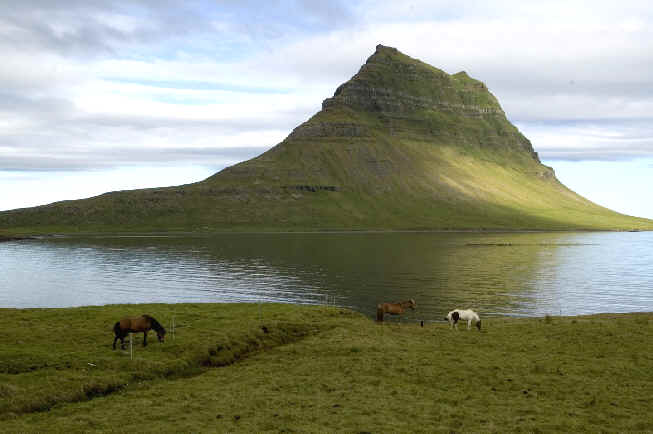
E-mail: font@focusonnature.com
Phone: Toll-free in USA 1-888-721-3555
or 302/529-1876
Website: www.focusonnature.com
 |
PO
Box 9021, Wilmington, DE 19809, USA E-mail: font@focusonnature.com Phone: Toll-free in USA 1-888-721-3555 or 302/529-1876 Website: www.focusonnature.com |
A FOCUS ON NATURE TOUR
in
Iceland
Our LATE-SPRING TOUR
For Birds and Other Nature
In The southern, western,
& Northern parts of the island
In an Enjoyable and Fascinating Land
June
5-14 2015
(tour: FON/IC-1
'15)
A tour at one of the most Picturesque Places on Earth
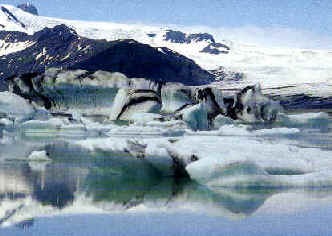
Vatanjokull Glacier
Among the birds:
Shorebirds & Waterbirds,
Seabirds & Landbirds,
where they breed.
Including: White-tailed Eagle, & Gyrfalcon,
Redwing & Redpoll, Puffins & a Pipit,
Wheatear, Wren, & Wagtail
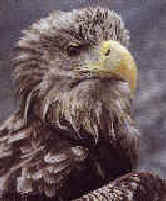
White-tailed Eagle
Due
to limited space on the airline, Icelandair,
reservations and ticketing for this tour to be done by April 30.
Links:
A
Complete
Iceland Bird-List
Birds
during previous FONT Tours in Iceland
A List and
Photo Gallery of European Birds, in 2 parts:
Part
#1: Grouse to Puffin
Part #2: Sandgrouse to Buntings
Lists with some Photos of: Icelandic Wildflowers
Icelandic Marine Life
Photos of Birds and Other Nature, Scenery and Culture during previous FONT
Iceland Tours:
in Sep/Oct 2013
in June 2012
in June
2009 in
June 2006
another
earlier tour
Highlights from Previous FONT Tours in Iceland
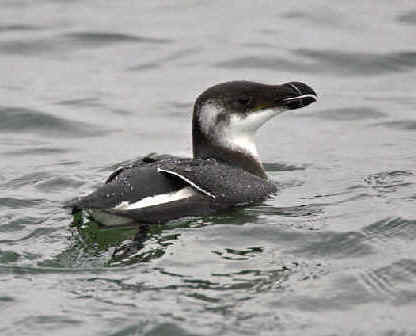
The Razorbill, one of the
alcids in Iceland.
Itinerary (price follows the itinerary information):
Tour participants would arrive in Iceland, the morning of Friday, June 5 (having left North America the evening of Thursday, June 4).
Departure from Iceland would be on
Sunday, June 14, (arriving in North America
the same day).
Flights to/from Iceland would be
on Icelandair. FONT will arrange these flights in conjunction with this tour
(either from/to Washington, New York (JFK), Boston, or
Minneapolis). FONT can arrange connecting flights
to/from these cities.
A General Overview of the Tour and What's to be Seen:
Eight nights would be spent in
Iceland:
two nights in the area of Reykjavik or
Keflavik (the first &
the last, Jun 5 & 13),
two nights in the north along a pristine coast (we've seen
Gyrfalcon, numerous Ptarmigan, nesting Pink-footed
Goose, and Great Skua during our previous tours in that area),
one night elsewhere in the north, from where we'll visit Lake Myvatn,
(a very good place for birds and botany),
one night in Stykkisholmur (by a beautiful bay known
as Breidafjordur),
and two nights along Iceland's southern coast.
We'll take a
boat-trip on that bay known as Breidafjordur in an area of islands to observe many birds, notably
alcids such as Puffins and Black Guillemots, and possibly marine
mammals.
Breidafjordur, by the way, is the
stronghold for the White-tailed Eagle in Iceland. We've
seen that species previously there during our Iceland tours. Our birding near
Reykjavik will include an area
of cliffs with numerous seabirds: gannets, kittiwakes, 2 species of murres,
razorbills, Arctic Terns, and fulmars.
The birding in Iceland in the spring will be excellent (and fun!). There will be daylight much of the time, as northern Iceland touches the Arctic Circle, and in late-May/June, of course, the days are at their longest.
Among the birds that we'll see
during these lengthy days on Iceland will be a number in full breeding attire on
their nesting grounds.
A number of them (both summer visitors and
year-long residents) are known by various names, depending upon, let's say,
the nationalities of the human observers (visitors and residents).
As
Iceland is a part of Europe, some birds with names that we know in America, are
called otherwise in "English" (as the British use another set of names).
So, among the breeding birds:
Red-throated Loon (or Diver),
Common Loon (or Great Northern Diver),
Horned (or Slavonian) Grebe, Oldsquaw
(or Long-tailed Duck), Red (or Grey)
Phalarope,
Parasitic Jaeger (or Arctic Skua),
Common Murre (or Guillemot),
Thick-billed
Murre (or Brunnich's Guillemot).
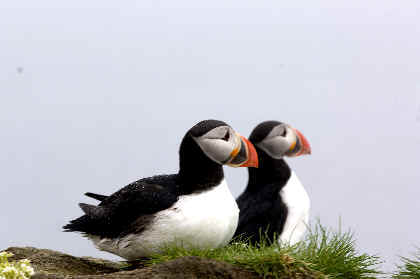
From 8 to 10
million Puffins
occur in Iceland in June.
More Atlantic Puffins nest there than anywhere else in the world.
In Iceland, the last home of the Great Auk, there are tremendous numbers of nesting alcids in the summer, with millions of Puffins, and thousands of Murres, Razorbills, and Black Guillemots. Also, there are large colonies of other seabirds including Gannets, Fulmars, Kittiwakes, Glaucous and other Gulls, and Arctic Tern. And Great Skua will be seen where they breed (in fact, seen where more breed than anywhere else in the world!)
We should also see, during the
tour, White-tailed
Eagles, white Gyrfalcon, Whooper Swans, Ptarmigan, and various
geese (including Pink-footed and possibly Barnacle),
eiders (and other ducks), shorebirds
including: Eurasian Oystercatcher, Ringed Plover, European Golden Plover, Redshank, Black-tailed
Godwit, and Red-necked Phalarope.
In addition to all these birds, there are also: Redwing & Redpoll,
and a Pipit; Wagtail & Wheatear, and a Wren.
During the tour, there will be a boat-trip during which we should observe numerous seabirds, and maybe some marine mammals. Among the possibilities: seals, porpoises, dolphins and whales. 25 species of marine mammals have been recorded in Icelandic waters.
Back on land, there's more: the geysers,
hot springs, and some truly spectacular Icelandic scenery. (The
word "geyser", you may know, originated in Iceland.)
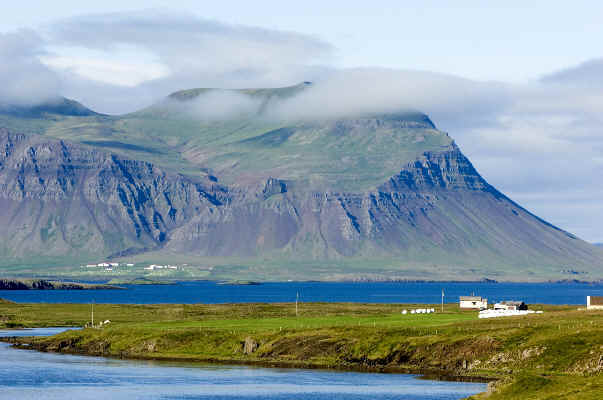
Icelandic scenery,
photographed during a FONT Tour.
This place, in the photo, is near the bay known as Breidafjordur.
More Details about Places to be Visited
Fri, June
5:
Arrival at
Our first day in
We'll stand right on the Mid-Atlantic Ridge, as fascinating as it is,
geologically, to see it at just about the only place where it's above ground.
Most of it, of course, south well into the
A number of small towns rim the Reykjanes
Sat, June 6:
Among some outstanding natural features in southern
Iceland's highest
mountain, Hvannadalshnjukur (6,950 feet)
sticks its head out above the ice.
Under the ice are several volcanoes, incluidng Grimsvotn. Some periodically
erupt and melt areas of ice.
On large spreads of sand and gravel, near the many glaciers, the bird known as
the Great Skua nests. More Great Skuas occur in that one part of
The southern Icelandic coast is very picturesque, where the mountains meet the
sea. On the cliffs, there are more Atlantic Puffins than anywhere else in the
world.
Waterfalls abound, including the impressive Svartifoss
(named after its black
lava columns), and Skogafoss, one of
Arctic Terns and Fulmars will seem to be "everywhere". Red-throated
Loons, Harlequin Ducks, and Harbor Seals will be at glacial pools.
Sun, Jun 7:
Mon, Jun 8:
The Great Geysir is probably the most famous geysir in the world, and it gave
its name (an Icelandic word) to all the others. The word means
"gusher".
Geysirs are spouting hot springs. In the Great Geysir area, there are geysirs, hot springs, mud springs, and fumeroles.
(All of these natural features have been given
their own Icelandic names.)
Unfortunately, the Great Geysir no longer erupts, as it once did like clockwork,
but its neighbor Strokkur ("a churn") is very active, erupting every 3
to 5 minutes, to a height of over 60 feet.
The name "Gullfoss" means "golden falls", after the
persistent rainbows that are formed by spray on sunny days. The River
Hvita,
swollen by melting snow and ice in the interior, drops more than 100 feet over
two falls.
Pingvellir is an outstanding place, as scenic as it is, by the large lake,
Pingvallavatn. It's also a famous place in Icelandic history, as it was the site
of an ancient outdoor parliament about a thousand years ago. On the lake, we'll
see waterbirds such as loons and various ducks. By the lake, in the area of
Pingvellir, we may well see ptarmigan.
We'll overnight, north & west of Pingvellir, by a beautiful fjord called Hrutajordur.
Tue, Jun 9:
That town, by a large bay, began as a trading post. Today, it's known for fish
processing. It's a pleasant town, around which there's much to see and enjoy.
One place, for example, is the Glaumbaer
Buried on the grounds is Snorri Porfinasson, who is believed to have been the
first European born in
We'll spend the night near Saudarkrokur.
Wed, Jun 10:
At Husavik, we'll take a boat-trip to see
whales and dolphins. At Lake Myvatn, we'll
see many birds. The lake has an area of 14 square miles, but it is shallow with an average
depth of just about 8 feet. And so, light penetrates to the bottom, making the
water rich in vegetation and nutrients, and thus very attractive to waterfowl.
There's probably no lake in the world with more ducks than Myvatn. The numbers
present in the summer can be staggering, with about 50,000 pairs and 15 species
of ducks, in addition to swans, grebes, phalaropes, and other birds that occur.
The lake contains about 50 islands, most of which are craters, looking like
mini-volcanoes. They were, in fact, formed by gas explosions. There has been
some volcanic activity in the area since the end of the Ice Age.
Observing the geological features and the numerous birds will make a most
interesting day. Our overnight will be back by Saudarkrokur.
Thu, Jun 11:
Fri, Jun 12: While on the north side on
the large Breidafjorour Bay, we'll venture
by ferry to an island in the bay, a rather special island, that we've visited in
the past, called Flatey. It's one of the
best places in Iceland to see nesting Red Phalarope. And even though the
bird is called the Grey Phalarope in Europe, it is called Red Phalarope
in Iceland, as it is red when it is there in its breeding plumage. Overnight by
the big bay known as Breidafjorour.
Sat, Jun 13:
Also on and by those
islands there will be more puffins, and other alcids including murres and
guillemots,
along with shags, eiders, and other birds that we'll see well.
We'll have some wonderful final looks at birds that we'll always relate to as
Icelandic.
In the afternoon, we'll head back toward the Reykjavik
area, with our last overnight in countryside before entering the
city.
Sun, Jun 14:
In the afternoon, we'll be at the international airport, outside
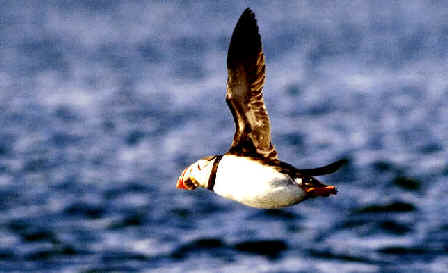
Oceanic birds, such as the Atlantic Puffin pictured above,
abound in
waters around Iceland.
We'll see thousands of them.
As noted, as many as 25 species of marine mammals
have been recorded in
Icelandic waters,
including the largest of all the creatures on earth, the Blue
Whale.
We should see some whales and dolphins during the tour.
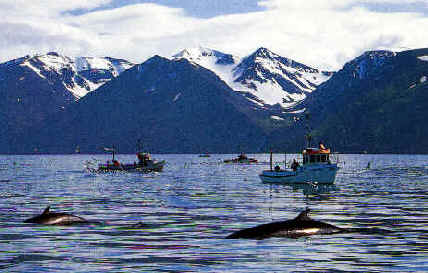
Dolphins off the north
coast of Iceland.
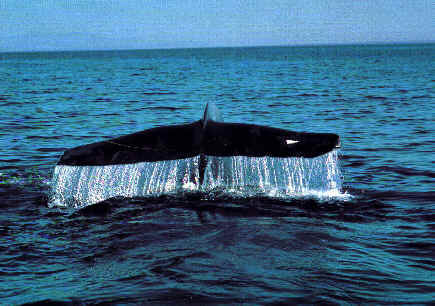
The tail of a Blue Whale
(the largest creature on earth).
Additionally, our time on land in Iceland will be all the more interesting,
with, in addition to birds,
some truly spectacular scenery, fascinating geology,
and a fine assortment of wildflowers.
You may consider joining us on our Late Spring 2015 Tour in Iceland
for a wonderful
experience!
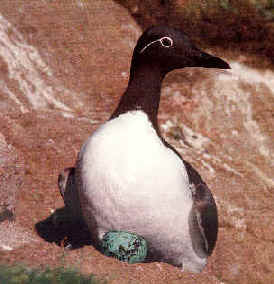
The bridled form
of the Guillemot,
or Common Murre.
The tour starts and ends at the international airport in Keflavik, Iceland.
Price:
US $3,195, per person, based upon double occupancy.
Single
supplement: US $425.
Includes:
All overnight accommodations.
Ground transportation & boat-rides.
Most meals: all breakfasts and
lunches.
The services of the FONT birding
leader.
Does not include:
Air transportation.
Dinners.
Drinks and any items of a personal
nature.
Gratuities.
Focus On Nature Tours
can handle your flight arrangements, to get the best
fare.
Tour to be led
by Armas Hill,
who has traveled in Iceland 19 times,
to see and share the birds & other nature.
A deposit of US
$500 is required to register for the Iceland tour.
